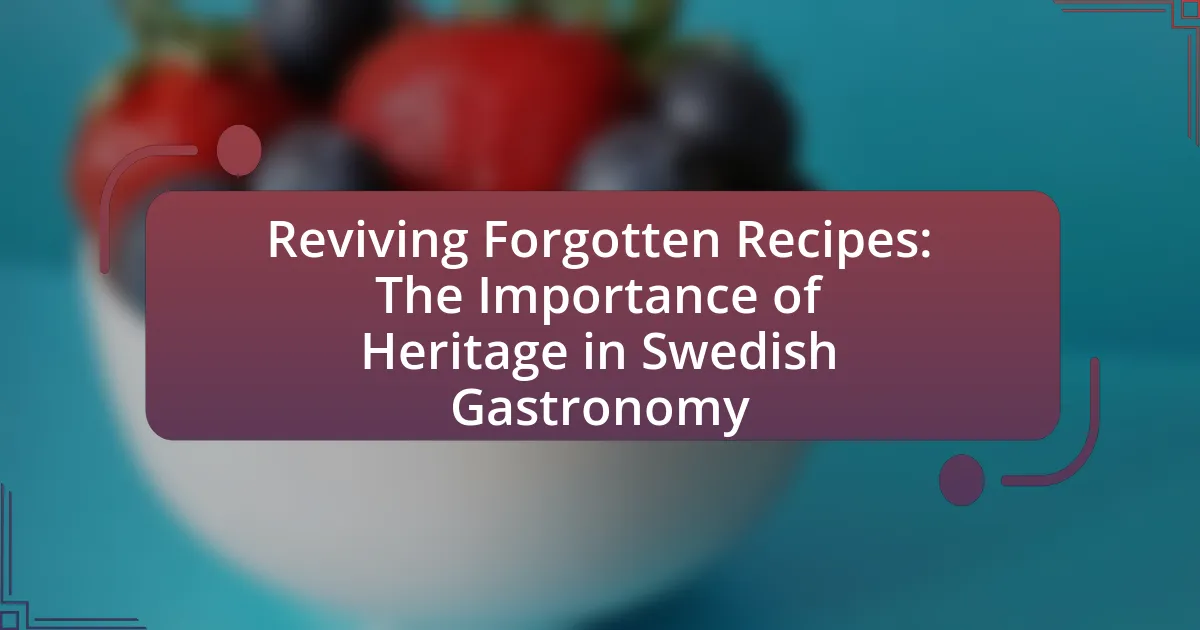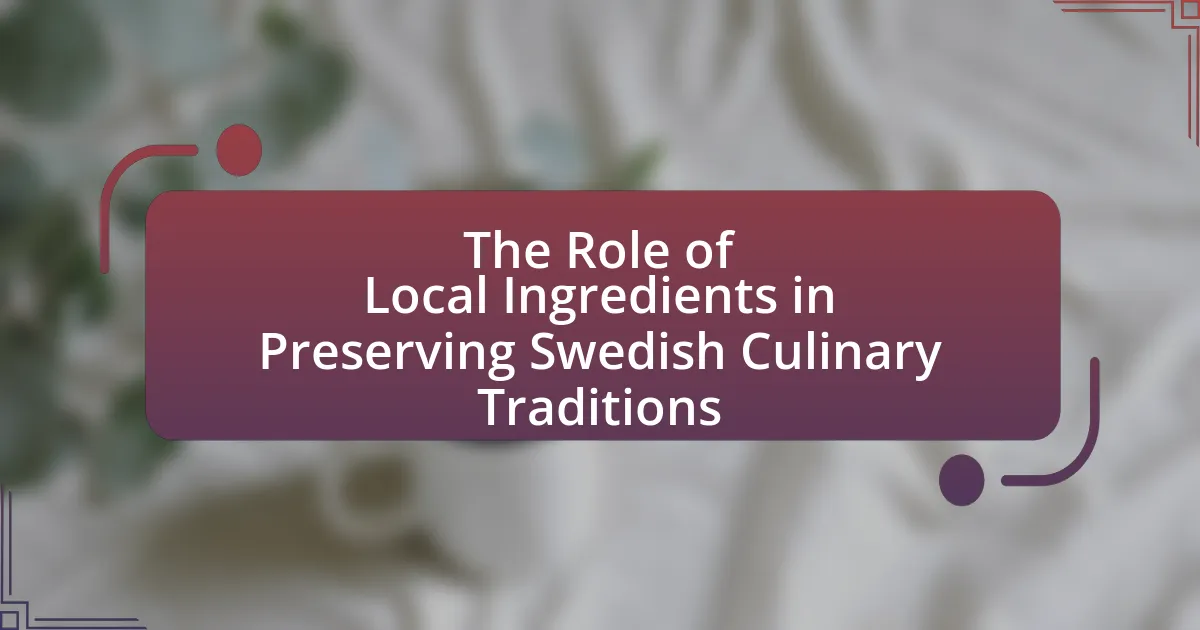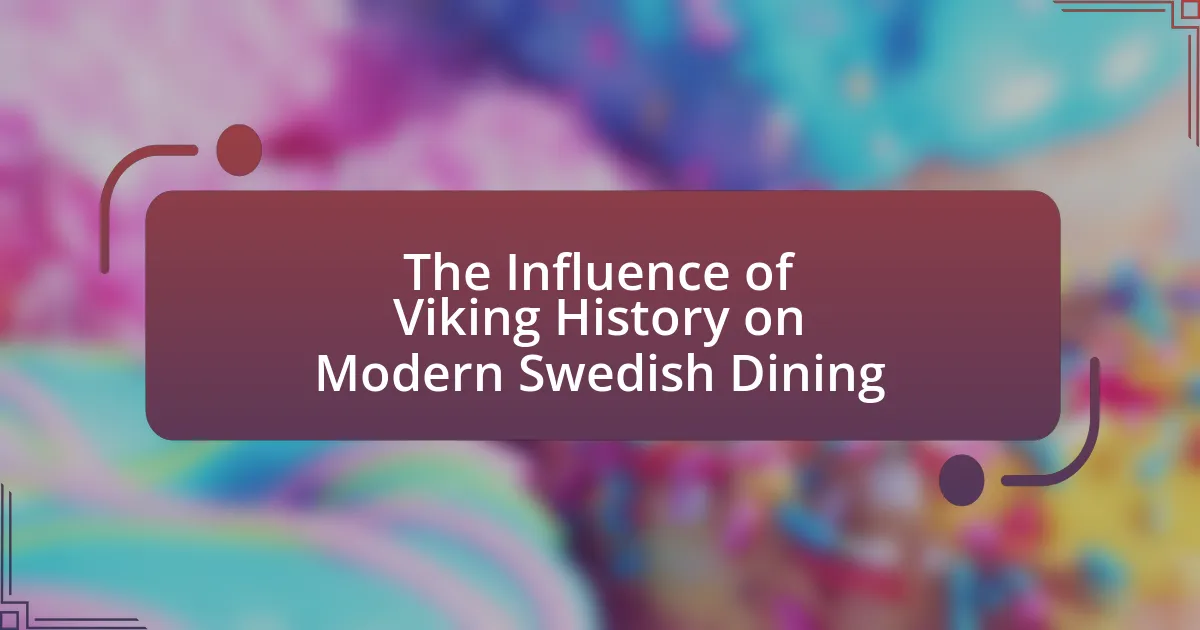The article focuses on how Swedish restaurants celebrate Midsummer, a significant cultural holiday marking the summer solstice. It outlines traditional dishes served during this festive period, such as herring, new potatoes, and strawberries, and highlights the importance of local ingredients and communal dining in Swedish culture. The article also discusses the role of decorations, events, and customer engagement strategies that enhance the Midsummer experience in restaurants. Additionally, it addresses the challenges faced by establishments during this peak season and offers best practices for successful celebrations, emphasizing the cultural significance of Midsummer in Sweden.
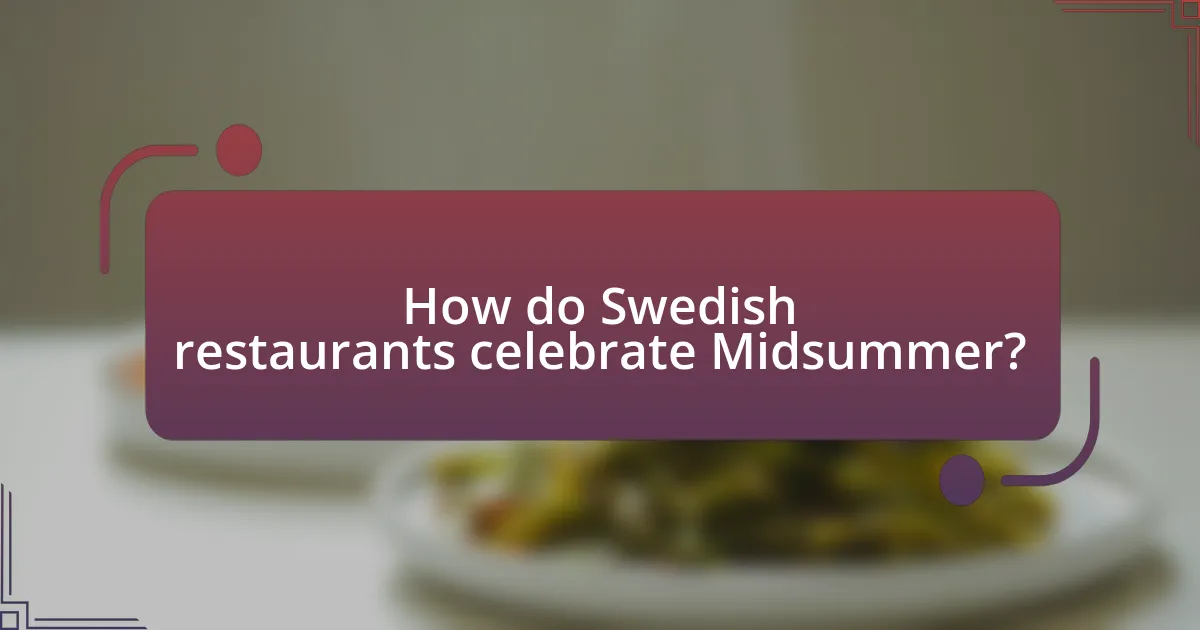
How do Swedish restaurants celebrate Midsummer?
Swedish restaurants celebrate Midsummer by offering traditional dishes and festive atmospheres that reflect the cultural significance of the holiday. During this time, many establishments serve classic foods such as herring, new potatoes, and strawberries, often accompanied by aquavit, a traditional Swedish spirit. Additionally, restaurants may host special events featuring live music, dancing around maypoles, and decorations that evoke the spirit of summer. This celebration aligns with the historical roots of Midsummer, which is one of Sweden’s most important holidays, marking the summer solstice and the arrival of longer days.
What traditional foods are served during Midsummer celebrations in Swedish restaurants?
Traditional foods served during Midsummer celebrations in Swedish restaurants include herring, new potatoes, sour cream, and chives. Herring is often prepared in various styles, such as pickled or marinated, and is a staple of the Midsummer feast. New potatoes, typically boiled and served with butter, complement the herring. Sour cream and chives are commonly used as condiments, enhancing the flavors of the dishes. Additionally, meatballs and gravlax, a type of cured salmon, are frequently featured, reflecting Sweden’s culinary heritage during this festive occasion.
How do these foods reflect Swedish culture and heritage?
Swedish foods reflect the culture and heritage through traditional ingredients and preparation methods that emphasize local resources and seasonal availability. For example, dishes like herring, gravlax, and meatballs showcase the importance of fish and meat in Swedish cuisine, which is rooted in the country’s geography and agricultural practices. The use of fresh, locally sourced ingredients during Midsummer celebrations highlights the Swedish value of sustainability and connection to nature. Additionally, the communal aspect of sharing meals, such as the traditional smorgasbord, illustrates the cultural significance of togetherness and family in Swedish society. These culinary practices are not only a means of sustenance but also a way to preserve and celebrate Swedish identity and traditions.
What are the most popular dishes associated with Midsummer?
The most popular dishes associated with Midsummer in Sweden include herring, new potatoes, sour cream, and fresh dill. Herring is traditionally served in various marinades, reflecting its significance in Swedish cuisine. New potatoes, often boiled and served with butter, symbolize the arrival of summer harvests. Sour cream and fresh dill complement these dishes, enhancing their flavors and contributing to the festive atmosphere. These culinary staples are integral to Midsummer celebrations, showcasing Sweden’s agricultural heritage and cultural traditions.
What role does decoration play in Midsummer celebrations at restaurants?
Decoration plays a crucial role in Midsummer celebrations at restaurants by creating an inviting and festive atmosphere that reflects Swedish cultural traditions. The use of flowers, particularly birch branches and wildflowers, symbolizes the arrival of summer and enhances the visual appeal of dining spaces. Additionally, traditional decorations like garlands and colorful table settings contribute to a sense of community and celebration, encouraging patrons to engage in the festivities. This practice is rooted in historical customs where vibrant decorations were essential for marking the significance of the Midsummer festival, thus reinforcing the cultural identity associated with this seasonal celebration.
How do Swedish restaurants incorporate traditional symbols into their decor?
Swedish restaurants incorporate traditional symbols into their decor by using elements such as Dala horses, traditional textiles, and floral motifs. Dala horses, which are iconic wooden toys painted in bright colors, symbolize Swedish craftsmanship and heritage, often displayed prominently in dining areas. Traditional textiles, including handwoven tablecloths and curtains featuring Swedish patterns, enhance the cultural ambiance and reflect the country’s artisanal history. Additionally, floral motifs, particularly those inspired by Midsummer celebrations, are used in centerpieces and wall art, connecting the decor to seasonal festivities and Swedish nature. These elements collectively create an authentic dining experience that celebrates Swedish culture and traditions.
What colors and themes are commonly used during Midsummer?
During Midsummer, the colors commonly used include blue, yellow, and green, reflecting the natural landscape of Sweden in summer. These colors symbolize the sky, sun, and lush greenery, respectively. Themes often revolve around nature, celebration, and traditional Swedish folklore, emphasizing floral decorations, maypoles adorned with flowers, and vibrant table settings that highlight the festive atmosphere of the season.
How do Swedish restaurants engage customers during Midsummer festivities?
Swedish restaurants engage customers during Midsummer festivities by offering traditional Midsummer menus that feature classic dishes such as herring, new potatoes, and strawberries. These establishments often create a festive atmosphere with decorations like flowers and may host events that include live music and dancing around the maypole, which is a central part of Midsummer celebrations in Sweden. Additionally, many restaurants provide outdoor seating to enhance the experience, allowing patrons to enjoy the long summer days. This engagement is supported by the cultural significance of Midsummer, which is one of Sweden’s most celebrated holidays, drawing both locals and tourists to partake in the festivities.
What types of events or activities are organized for patrons?
Swedish restaurants organize various events and activities for patrons during Midsummer, including traditional feasts, flower crown-making workshops, and live music performances. These events celebrate Swedish culture and customs, allowing patrons to engage in communal dining experiences featuring seasonal dishes like herring and new potatoes. Additionally, flower crown-making workshops provide a hands-on activity that connects participants to the Midsummer tradition of adorning oneself with flowers. Live music performances often feature folk music, enhancing the festive atmosphere and encouraging dancing, which is a key aspect of Midsummer celebrations in Sweden.
How do restaurants create a festive atmosphere for Midsummer?
Restaurants create a festive atmosphere for Midsummer by incorporating traditional decorations, special menus, and themed events. They often adorn their spaces with flowers, particularly birch branches and wildflowers, which are symbolic of the season. Additionally, restaurants may offer a menu featuring classic Midsummer dishes such as herring, new potatoes, and strawberries, enhancing the cultural experience. Live music and dancing are also common, as many establishments host events that encourage communal celebration, reflecting the social nature of Midsummer festivities in Sweden. These elements collectively contribute to an immersive and joyful environment that resonates with the cultural significance of the holiday.

Why is Midsummer significant in Swedish culture?
Midsummer is significant in Swedish culture as it marks the celebration of the summer solstice, which is the longest day of the year. This festival, deeply rooted in ancient traditions, symbolizes fertility, the arrival of summer, and the joy of nature’s abundance. Celebrated with various customs such as dancing around the maypole, singing traditional songs, and enjoying seasonal foods like herring and new potatoes, Midsummer reflects the importance of community and family gatherings in Swedish society. The event is so culturally embedded that it is considered one of the most important holidays in Sweden, with many Swedes taking time off work to participate in the festivities.
What historical events led to the celebration of Midsummer in Sweden?
The celebration of Midsummer in Sweden is rooted in ancient agricultural practices and pagan traditions. Historically, the summer solstice marked the longest day of the year, which was significant for agrarian societies as it symbolized fertility and the abundance of crops. The arrival of Christianity in Sweden during the 11th century incorporated these pagan customs, leading to the establishment of Midsummer as a Christian feast day celebrating St. John the Baptist. This blending of traditions solidified Midsummer as a key cultural event, characterized by rituals such as dancing around the maypole and feasting, which continue to be central to modern celebrations.
How has the significance of Midsummer evolved over time?
The significance of Midsummer has evolved from ancient pagan rituals celebrating the summer solstice to a modern cultural festival in Sweden. Initially, Midsummer was a time for fertility rites and agricultural celebrations, marked by bonfires and various customs aimed at ensuring a bountiful harvest. Over time, particularly in the 19th century, it transformed into a national holiday emphasizing family gatherings, traditional foods, and folk music, reflecting Sweden’s cultural identity. Today, Midsummer is celebrated with maypole dancing, flower crowns, and a focus on community, showcasing its shift from agricultural roots to a broader cultural celebration.
What cultural practices are associated with Midsummer in Sweden?
Cultural practices associated with Midsummer in Sweden include the raising of the maypole, traditional dancing, and the preparation of special foods. The maypole, or “midsommarstång,” is decorated with flowers and greenery, symbolizing fertility and the arrival of summer. During the celebration, people engage in folk dances around the maypole, often accompanied by singing traditional songs. Additionally, Swedish cuisine features dishes such as herring, new potatoes, and strawberries, which are commonly enjoyed during Midsummer feasts. These practices reflect Sweden’s agrarian roots and the importance of nature in Swedish culture, celebrating the longest day of the year with communal joy and festivity.
How do Midsummer celebrations differ across various regions of Sweden?
Midsummer celebrations in Sweden vary significantly by region, reflecting local customs and traditions. In southern Sweden, particularly in Skåne, the festivities often include elaborate flower crowns and traditional dances around the maypole, emphasizing a strong connection to nature and agriculture. In contrast, central Sweden, including Stockholm, features a more urban celebration with a focus on family gatherings, traditional foods like herring and new potatoes, and singing folk songs. Northern Sweden, particularly in Lapland, incorporates indigenous Sami elements, such as reindeer dishes and traditional Sami music, showcasing a unique cultural heritage. These regional differences highlight the diverse ways in which Midsummer is celebrated across Sweden, influenced by local history, geography, and cultural practices.
What unique traditions are observed in different Swedish cities?
Unique traditions observed in different Swedish cities during Midsummer include the maypole dancing in Uppsala, where locals gather to raise and decorate a maypole, symbolizing fertility and summer. In Stockholm, the tradition of singing traditional songs while enjoying herring and new potatoes is prevalent, reflecting the city’s culinary heritage. Gothenburg celebrates with a seafood feast, emphasizing its coastal culture, while Malmö incorporates a blend of music and dance, showcasing local artists. Each city’s unique customs highlight regional variations in celebrating this significant cultural event.
How do local ingredients influence Midsummer menus in different regions?
Local ingredients significantly influence Midsummer menus across different regions by reflecting the seasonal availability and cultural preferences of each area. For instance, in Sweden, traditional Midsummer dishes often feature locally sourced herring, new potatoes, and fresh dill, which are abundant during the summer months. This reliance on local produce not only enhances the flavor and freshness of the meals but also connects the celebration to the region’s agricultural practices and culinary heritage. In contrast, regions with different climates may incorporate other local ingredients; for example, coastal areas might emphasize seafood, while inland regions may focus on meats and root vegetables. This regional variation showcases how local ecosystems and agricultural outputs shape the culinary landscape during Midsummer celebrations.
What impact does Midsummer have on Swedish society today?
Midsummer significantly impacts Swedish society today by reinforcing cultural identity and fostering community connections. This annual celebration, marked by traditional activities such as dancing around the maypole and enjoying seasonal foods, serves as a vital expression of Swedish heritage. According to a study by the Swedish Institute, over 80% of Swedes participate in Midsummer festivities, highlighting its importance in contemporary social life. The event not only strengthens familial bonds but also promotes local tourism, as many restaurants and businesses offer special Midsummer menus and events, contributing to the economy.
How do modern interpretations of Midsummer reflect contemporary values?
Modern interpretations of Midsummer reflect contemporary values by emphasizing inclusivity, sustainability, and a connection to nature. These interpretations often showcase diverse cultural practices, allowing for a broader representation of community and identity, which aligns with today’s focus on inclusivity. Additionally, many celebrations incorporate sustainable practices, such as using locally sourced ingredients and minimizing waste, reflecting the growing societal emphasis on environmental responsibility. For instance, Swedish restaurants may highlight organic produce and traditional dishes while promoting eco-friendly practices, thus reinforcing the value of sustainability in modern society.
What role does Midsummer play in community bonding and social gatherings?
Midsummer serves as a pivotal occasion for community bonding and social gatherings in Sweden. This celebration, marked by traditional activities such as dancing around the maypole, feasting on seasonal foods, and engaging in folk games, fosters a sense of unity among participants. Historical practices indicate that Midsummer has been celebrated since ancient times, emphasizing the importance of nature and the summer solstice, which further strengthens communal ties. The collective participation in rituals and festivities creates shared experiences, reinforcing social connections and cultural identity within communities.
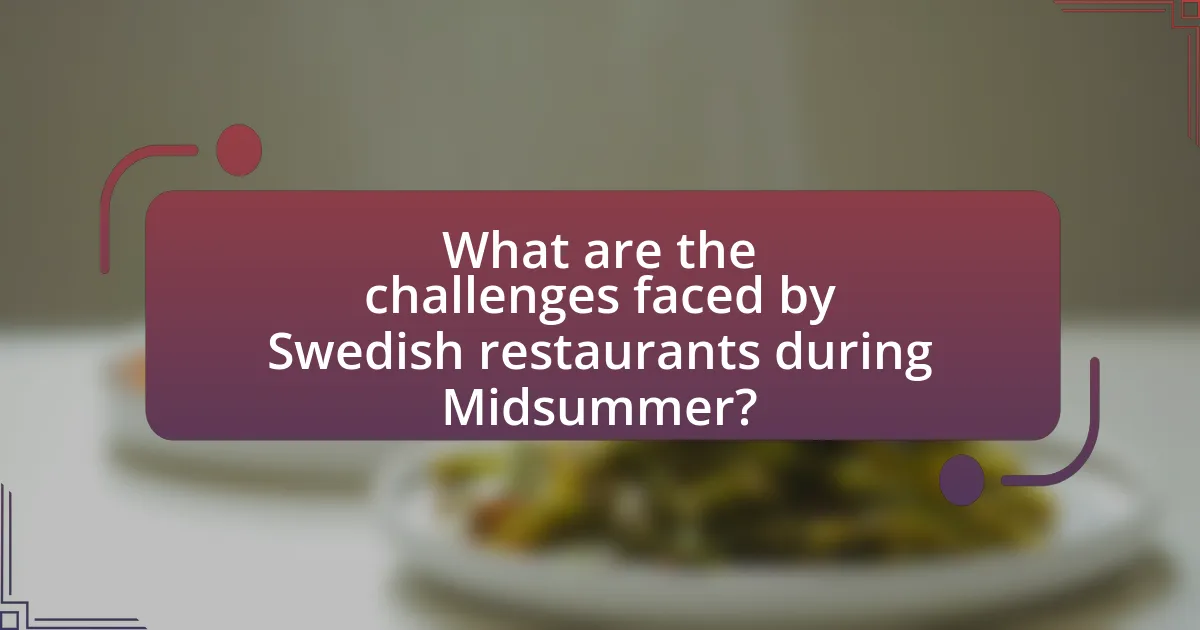
What are the challenges faced by Swedish restaurants during Midsummer?
Swedish restaurants face several challenges during Midsummer, primarily due to increased demand and staffing shortages. The surge in customers seeking traditional Midsummer meals, such as herring and new potatoes, often overwhelms kitchen and service staff, leading to longer wait times and potential declines in food quality. Additionally, many restaurants struggle with supply chain issues, as specific seasonal ingredients may be in high demand and short supply, complicating menu planning. Furthermore, the festive atmosphere can lead to higher expectations from patrons, putting additional pressure on restaurant operations to deliver exceptional service and dining experiences.
How do restaurants manage increased demand during Midsummer celebrations?
Restaurants manage increased demand during Midsummer celebrations by implementing strategic staffing, menu adjustments, and reservation systems. To accommodate the surge in customers, many establishments hire additional temporary staff to ensure efficient service. They often expand their menus to include traditional Midsummer dishes, such as herring and new potatoes, which attract more patrons. Furthermore, restaurants frequently encourage reservations to manage the flow of guests, reducing wait times and enhancing the dining experience. These practices are essential for handling the high volume of diners during this culturally significant event in Sweden, where Midsummer is celebrated with gatherings and feasting.
What strategies are employed to ensure quality service during peak times?
Swedish restaurants employ several strategies to ensure quality service during peak times, particularly during Midsummer celebrations. These strategies include increasing staff levels to manage higher customer volumes, implementing reservation systems to streamline guest flow, and training employees to handle high-pressure situations effectively. For instance, many restaurants may hire temporary staff or offer overtime to existing employees to ensure adequate coverage. Additionally, reservation systems help manage customer expectations and reduce wait times, which is crucial during busy periods. Training programs focused on efficiency and customer service skills further enhance the ability of staff to maintain service quality even when demand is at its peak.
How do restaurants handle supply chain issues for seasonal ingredients?
Restaurants manage supply chain issues for seasonal ingredients by establishing strong relationships with local farmers and suppliers to ensure consistent access to fresh produce. This approach allows restaurants to adapt their menus based on availability, thereby minimizing the impact of supply chain disruptions. For instance, many Swedish restaurants celebrate Midsummer by sourcing traditional ingredients like herring and new potatoes directly from local producers, which not only supports the local economy but also enhances the freshness of the dishes served. Additionally, restaurants may implement inventory management systems to forecast demand and adjust orders accordingly, ensuring they have the necessary ingredients during peak seasons.
What are the common pitfalls to avoid when celebrating Midsummer in restaurants?
Common pitfalls to avoid when celebrating Midsummer in restaurants include neglecting traditional food offerings, failing to create an authentic atmosphere, and overlooking customer engagement. Traditional food offerings, such as herring, new potatoes, and strawberries, are essential for an authentic Midsummer experience; omitting these can lead to customer dissatisfaction. Creating an authentic atmosphere involves incorporating elements like floral decorations and traditional music; neglecting this can result in a lackluster celebration that fails to resonate with patrons. Lastly, engaging customers through activities like dancing or singing traditional songs enhances the experience; ignoring this aspect can lead to a missed opportunity for memorable interactions.
How can restaurants ensure they meet customer expectations during Midsummer?
Restaurants can ensure they meet customer expectations during Midsummer by offering traditional Swedish dishes and creating a festive atmosphere. By incorporating popular Midsummer foods such as herring, new potatoes, and strawberries, restaurants align their menus with cultural expectations. Additionally, enhancing the dining experience with decorations like flowers and maypoles can evoke the celebratory spirit of the holiday. According to a survey by the Swedish Restaurant Association, 75% of customers prefer dining at establishments that embrace local traditions during cultural celebrations, highlighting the importance of authenticity in meeting customer expectations.
What lessons can be learned from past Midsummer celebrations in restaurants?
Past Midsummer celebrations in restaurants highlight the importance of seasonal ingredients and cultural authenticity in menu offerings. Restaurants that incorporated local produce and traditional dishes, such as herring and new potatoes, experienced higher customer satisfaction and repeat business. For instance, a study by the Swedish Institute found that restaurants emphasizing cultural heritage during Midsummer attracted more patrons, demonstrating that aligning with local customs enhances the dining experience. Additionally, successful celebrations often included community engagement through events like folk dancing and live music, which fostered a festive atmosphere and increased customer participation. This indicates that creating an immersive cultural experience can significantly boost a restaurant’s appeal during seasonal celebrations.
What best practices can restaurants adopt for successful Midsummer celebrations?
Restaurants can adopt several best practices for successful Midsummer celebrations, including offering traditional Swedish dishes, creating a festive atmosphere, and engaging with the community. Serving classic foods such as herring, new potatoes, and strawberries aligns with cultural expectations and enhances the dining experience. Additionally, decorating the restaurant with flowers, greenery, and Midsummer poles fosters a celebratory environment that attracts customers. Engaging with local traditions, such as hosting live music or dance performances, can further draw in patrons and create a sense of community. These practices not only honor Swedish culture but also increase customer satisfaction and loyalty during this significant holiday.
How can restaurants effectively promote their Midsummer offerings?
Restaurants can effectively promote their Midsummer offerings by leveraging social media campaigns, local partnerships, and themed events. Social media platforms like Instagram and Facebook allow restaurants to showcase visually appealing dishes and engage with customers through targeted ads, which can increase visibility and attract diners interested in Midsummer celebrations. Collaborating with local businesses, such as florists or breweries, can enhance promotional efforts by creating package deals or joint events that draw in a wider audience. Additionally, hosting themed events, such as Midsummer feasts or live music nights, can create a festive atmosphere that encourages patrons to experience the cultural significance of Midsummer while enjoying special menu items. These strategies are supported by the fact that restaurants that actively engage with their community and utilize digital marketing see a significant increase in customer engagement and foot traffic during seasonal events.
What tips can enhance the overall Midsummer experience for customers?
To enhance the overall Midsummer experience for customers, Swedish restaurants should focus on offering traditional dishes, engaging activities, and a festive atmosphere. Providing authentic Midsummer foods such as herring, new potatoes, and strawberries creates a genuine cultural experience. Engaging activities like flower crown making or traditional dancing can further immerse customers in the celebration. Additionally, decorating the restaurant with Midsummer themes, such as maypoles and wildflowers, contributes to a festive ambiance that resonates with the cultural significance of the holiday. These elements collectively enrich the customer experience by fostering a deeper connection to Swedish Midsummer traditions.



